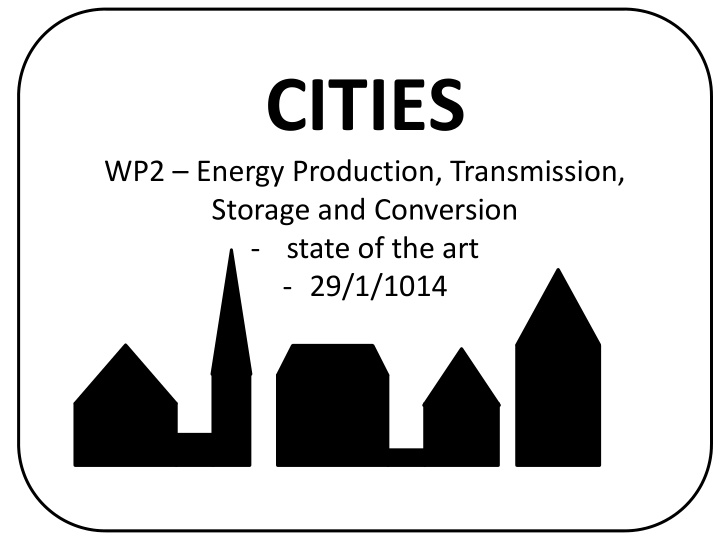



CITIES WP2 – Energy Production, Transmission, Storage and Conversion - state of the art - 29/1/1014
Agenda 1. What should we end up with 2. State of the art - Energy production 3. State of the art - Energy transmission/distribution 4. State of the art - Energy storage and conversion 5. Partners and budget 6. Ideas and focus area: aim, tasks, subtasks
Concept Integration through the use of intelligence which is made possible by operational and stochastic models WP2
State of the art Energy Production A reminder: • Technically the term “Energy Production” is nonsense – cf. 1 st law of thermodynamics • In WP2 we will adopt the understanding that Energy Production is the first conversion process required to transform primary energy into a demanded form of energy • Examples: wind energy into electricity, chemical energy of coal into heat and electricity
State of the art Energy Production • Energy is produced within cities – Large central power plants using • waste, biomass, coal or gas – Local solar heat and power – Oil refineries – often placed in cities • Using crude oil for production of refined oil products mainly for transport • Energy production in cities will take new forms – Fossils will be phased out
State of the art Energy transmission and distribution • Energy is transmitted to cities – sometimes from distant locations – E.g. natural gas and electrical power • Energy is distributed within the cities – District heating grids, power and gas grids, transport fuel infrastructure
State of the art Energy Storage and Conversion • Energy storage is used extensively in cities – However, we store fossil fuels for dispatchable use in power plants aafintl.com aafintl.com – This will change – storing renewables will become a fully integrated part of cities´ energy system
Danish Partners in WP2:
Total Efforts of WP2: One Post Doc starting earliest possible One Ph.D. student starting 2015 2 months´ senior effort per year Plus efforts from many partners
WP2: Energy Production, Transmission, Storage and Conversion Aim: WP2 is responsible for characterizing and modelling energy handling in cities. WP2 is complementary to WP1 and should • Characterize and model Energy production Energy transmission/distribution Energy storage and Energy conversion • Assess the resources required to provide the energy services and demand identified and modelled in WP1.
WP2: Energy Production,Transmission, Storage and Conversion Aim: Characterize energy supply, transmission, storage and conversion possibilities and identify opportunities for increased efficiency and flexibility. WP2.1: Establish the availability of energy production resources. The accessible capacity, efficiency and related costs will be investigated, as well as spatio-temporal variations. Characterize cities´ energy production from solar thermal and voltaic installations, waste/excess heat from industrial processes, heat generated in conversion processes (e.g. gas to power), thermal output from heat pumps and more….. WP2.2: Study possibilities for energy storage. This includes virtual storage by energy systems integration, for instance interaction between gas and power. Internal storage of heat and electricity in buildings, households and industry, underground storage of heat and more…..
WP2: Energy Production,Transmission, Storage and Conversion Aim: Characterize energy supply, transmission, storage and conversion possibilities and identify opportunities for increased efficiency and flexibility. WP2.3: Study of various energy conversion techniques and the most usable energy forms for storage and transportation. Gas to power and vice versa, electricity to heat in heat pumps or electrical heaters, ….. WP2.4: Develop models of (gas, power, district heating) networks . Sources and sinks for power determining power flows, optimize power flow (minimize investments) WP2.5: Build tools for identifying flexibility and efficiency potential within the system, including topology optimization for intelligent networks and multi-horizon and cross- resource scheduling tools. E.g. assess flexibility potential of energy use and utilize results for improving efficiencies and capacity factors of renewable sources.
WP2 PhD project • Model energy flows within cities (electric power, gas and heat) based on demanded energy services derived in WP1 energy influx from city-external sources energy generated internally in cities. • Identify needs for conversion and storage of energy to meet service demand. • Supervisor: Allan S. Pedersen, DTU Energy Conversion • Co-Supervisor: M.P. Sørensen, DTU Compute
Time schedule • Milestone 3: First annual conference • Milestone 5’:Delivery of preliminary supply models • Milestone 5: Delivery of final supply models
First tasks • Employ Post Doc - urgent • Interact with interested partners – primarily WP partners • Design of case studies in collaboration between WP2 partners and WP1
Recommend
More recommend